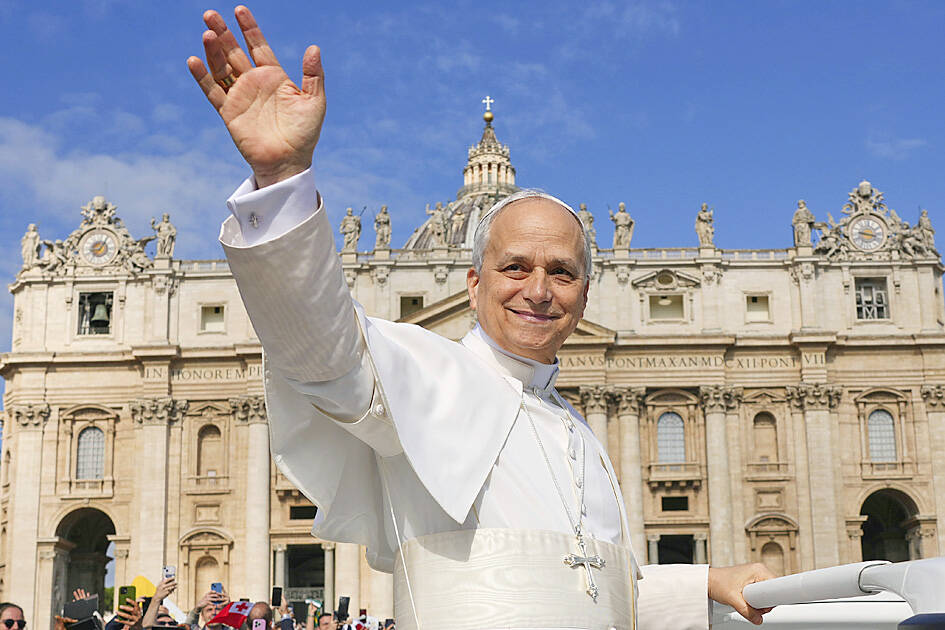Pope Leo XIV, history’s first US pope, yesterday vowed to work for unity so that the Catholic Church becomes a sign of peace in the world, offering a message of communion during an inaugural Mass in St Peter’s Square before an estimated 200,000 pilgrims, presidents, patriarchs and princes.
Leo officially opened his pontificate by taking his first popemobile tour through the piazza, a rite of passage that has become synonymous with the papacy’s global reach and mediatic draw. The 69-year-old Augustinian missionary smiled and waved from the back of the truck, but did not appear to stop to kiss babies and the crowd.
During the Mass, Leo appeared to choke up when the two potent symbols of the papacy were placed on him — the lambswool stole over his shoulders and the fisherman’s ring on his finger — as if the weight of responsibility of leading the 1.4 billion strong church had just sunk in.

Photo: AP
He turned his hand to look at the ring and seal, and then clasped his hands in front of him in prayer.
US Vice President J.D. Vance, one of the last foreign officials to see Pope Francis before he died, led the US delegation honoring the Chicago-born Leo after paying his respects at the Argentine pope’s tomb upon arriving in Rome late on Saturday.
In his homily, Leo said he wanted to be a servant to the faithful through the two dimensions of the papacy, love and unity, so that the church could be a force for peace in the world.
“I would like that our first great desire be for a united church, a sign of unity and communion, which becomes a leaven for a reconciled world,” he said. “In this our time, we still see too much discord, too many wounds caused by hatred, violence, prejudice, the fear of difference, and an economic paradigm that exploits the Earth’s resources and marginalizes the poorest.”
His call for unity was significant, given the polarization in the Catholic Church in the US and beyond.

Authorities have detained three former Taiwan Semiconductor Manufacturing Co (TMSC, 台積電) employees on suspicion of compromising classified technology used in making 2-nanometer chips, the Taiwan High Prosecutors’ Office said yesterday. Prosecutors are holding a former TSMC engineer surnamed Chen (陳) and two recently sacked TSMC engineers, including one person surnamed Wu (吳) in detention with restricted communication, following an investigation launched on July 25, a statement said. The announcement came a day after Nikkei Asia reported on the technology theft in an exclusive story, saying TSMC had fired two workers for contravening data rules on advanced chipmaking technology. Two-nanometer wafers are the most

NEW GEAR: On top of the new Tien Kung IV air defense missiles, the military is expected to place orders for a new combat vehicle next year for delivery in 2028 Mass production of Tien Kung IV (Sky Bow IV) missiles is expected to start next year, with plans to order 122 pods, the Ministry of National Defense’s (MND) latest list of regulated military material showed. The document said that the armed forces would obtain 46 pods of the air defense missiles next year and 76 pods the year after that. The Tien Kung IV is designed to intercept cruise missiles and ballistic missiles to an altitude of 70km, compared with the 60km maximum altitude achieved by the Missile Segment Enhancement variant of PAC-3 systems. A defense source said yesterday that the number of

A bipartisan group of US representatives have introduced a draft US-Taiwan Defense Innovation Partnership bill, aimed at accelerating defense technology collaboration between Taiwan and the US in response to ongoing aggression by the Chinese Communist Party (CCP). The bill was introduced by US representatives Zach Nunn and Jill Tokuda, with US House Select Committee on the Chinese Communist Party Chairman John Moolenaar and US Representative Ashley Hinson joining as original cosponsors, a news release issued by Tokuda’s office on Thursday said. The draft bill “directs the US Department of Defense to work directly with Taiwan’s Ministry of National Defense through their respective

Tsunami waves were possible in three areas of Kamchatka in Russia’s Far East, the Russian Ministry for Emergency Services said yesterday after a magnitude 7.0 earthquake hit the nearby Kuril Islands. “The expected wave heights are low, but you must still move away from the shore,” the ministry said on the Telegram messaging app, after the latest seismic activity in the area. However, the Pacific Tsunami Warning System in Hawaii said there was no tsunami warning after the quake. The Russian tsunami alert was later canceled. Overnight, the Krasheninnikov volcano in Kamchatka erupted for the first time in 600 years, Russia’s RIA